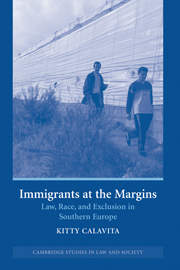Book contents
- Frontmatter
- Contents
- List of tables
- Preface
- Acknowledgments
- Maps
- 1 Introduction
- 2 Legal framework and the wayward “legs of law”
- 3 “Useful invaders”: the economics of alterité
- 4 Integrating the “Other”
- 5 The Everyday dynamics of exclusion: work, health, and housing
- 6 Fuel on the fire: politics, crime, and racialization
- 7 Conclusion: immigrants and other strangers in the global marketplace
- Notes
- Bibliography
- Index
4 - Integrating the “Other”
Published online by Cambridge University Press: 04 July 2009
- Frontmatter
- Contents
- List of tables
- Preface
- Acknowledgments
- Maps
- 1 Introduction
- 2 Legal framework and the wayward “legs of law”
- 3 “Useful invaders”: the economics of alterité
- 4 Integrating the “Other”
- 5 The Everyday dynamics of exclusion: work, health, and housing
- 6 Fuel on the fire: politics, crime, and racialization
- 7 Conclusion: immigrants and other strangers in the global marketplace
- Notes
- Bibliography
- Index
Summary
David Engel, in his now classic article, “The Oven Bird's Song,” recalls Yamaguchi's description of an old Japanese legend in which a “calamity that attacked the community had its origin in an alien factor inside the community … However … the alien element, which could turn into calamity at any time, was absolutely necessary for the growth of the crops. Thus the need for the alien factor had two facets which appear contradictory to each other.”
Just as the “alien factor” in this legend – and the outsiders in Engel's Sander County – contribute to economic development but are perceived as “calamitous” for the community, so contemporary immigrants in Italy and Spain are both wanted for their labor and suspect for their Otherness and the anticipated consequences of that Otherness for the community. The consequences are not just imagined, the paranoid fantasy of racist fearmongers. Rather, the immigrant marginality that is so beneficial to the economy creates a class of outcasts that is unacceptable to liberal democracies heralding inclusiveness, and is politically explosive as it invites nativist backlash against this element that is “absolutely necessary for the growth of the crops.” As we have seen, immigration policies in Italy and Spain follow closely the contours of this contradiction.
In this chapter, I discuss the various meanings of immigrant integration, and trace the laws, policies, and programs designed to promote it. These efforts are extensive and cannot be dismissed as merely symbolic gestures or political performances.
- Type
- Chapter
- Information
- Immigrants at the MarginsLaw, Race, and Exclusion in Southern Europe, pp. 75 - 98Publisher: Cambridge University PressPrint publication year: 2005

